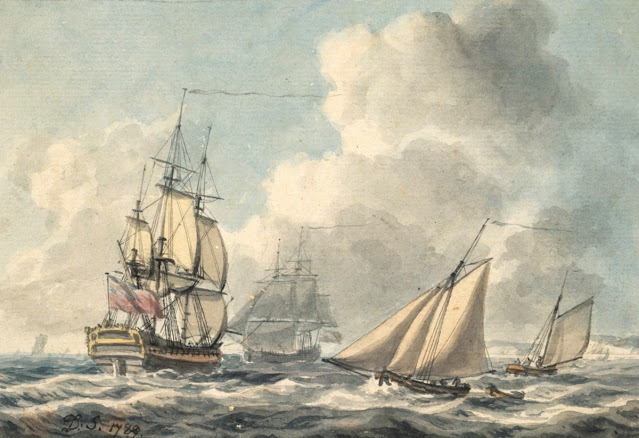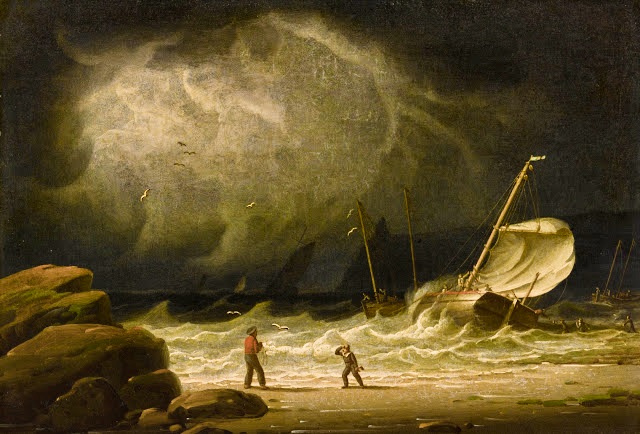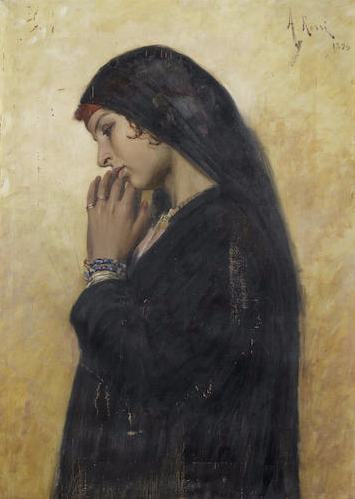Orientalism is a term that is used for the depiction of aspects in Middle Eastern cultures. It refers to the works of the Western artists on Oriental subjects, produced from their travels in Western Asia, during the 19th century. Depictions of Islamic "Moors" and "Turks" can be found in Medieval, Renaissance, and Baroque art. A creative apprehension of a completely different world with its own laws, customs, special attitude towards life and death, love, feelings, and beauty. Wikipedia/Yana Naumovna Lukashevskaya
Henri Emilien Rousseau, French, 1875-1933
Cavalier des Ouled Sidi-Cheikh/ Rider of the Ouled Sidi-Cheikh
Oil on board
6 3/8 x 4 3/4 inches
Private collection
Sidi Sheikh Ben Abu Bekr was a holy marabout, descending in direct line from Abu Bakr , the companion of the Prophet Muhammad, the first caliph of Islam, and his descendants in their genealogy, uninterrupted, go up to Adam . It would be seen very badly, in the Algerian Sahara, if this ancient and venerable nobility were disputed.
Sidi Sheikh according to legend, was a person of exemplary piety and holiness, with the gift of performing miracles, which he passed on to his posterity and especially to the eldest of his descendants. He had an immense influence over all the populations between the border of Morocco and Jebel Amour. More on Sidi Sheikh Ben Abu Bekr
Henri Rousseau Henry, Emilien Rousseau
(Cairo 1875 - Aix-en-Provence in 1933) is an Orientalist painter. A pupil of
Jean-Léon Gérôme at the Beaux Arts in Paris, he won the second Grand Prix de
Rome in 1900 and a travel grant at the Salon of French Artists. He traveled to
Belgium, the Netherlands, North Africa, Spain and Italy where he admired the
great masters (Rubens, Rembrandt, Velasquez, Murillo, the Titian, Raphael etc
...)
After this initiatory journey, he settled in
Versailles and set up his studio at the Villa des Arts in Paris. In 1919 he
moved to Aix in Provence with his large family (seven children). Knight of the
Legion of Honour in arts. His work is dedicated to
Tunisia, Algeria and especially Morocco, Provence and the Camargue remained its
anchor points. His success was with a bourgeois and wealthy clientele, where he
sold his work at numerous exhibitions in Paris, Brussels, Stockholm, Marseilles. More Henri Rousseau
Anders Zorn, (1860–1920)
Kaikroddare
Oil on canvas
Private collection
Quay rowers , also known as Turkish rowers in the port of Constantinople , is a watercolor painting by Anders Zorn from 1886 that is available in four versions. The first two are owned by public institutions, the Zorn collections in Mora and the National Museum in Stockholm , while the latter two are part of private collections.
It was in Constantinople that Zorn laid the foundation for his interest in water surfaces. He was also fascinated by the slender rowing boats called kaik, its rowers and the lively shimmering city buildings that loom in the background of the picture. "I soon began to paint on the water," he writes in his memoirs, thus revealing that he was sitting in the stern of the boat, from where he was able to study the whole muscular rower's muscle game.
On the first version, the Mora version, Zorn has written "Constantinople Jan 86" in the lower right corner. The second (slightly smaller) version, which the National Museum calls a Turkish rower in the port of Constantinople , is also made in Constantinople. However, the third and possibly also the fourth are painted in Paris. The Mora version focuses on the quay rowing and the power of his movements. In the background of the image, the contours of Topkapi Palace on Seraljudden are glimpsed. In the second version, more details have been added, including an oncoming quay and a larger sailing ship in the background. The two later paintings are slightly larger and contain an image composition similar to the painting at the National Museum. The version available in the National Museumcollections were bequeathed to the museum in 1892 by Gustaf Maurits Lamm , cousin of Emma Zorn.
More on this painting
Anders Leonard Zorn (18 February 1860 – 22 August 1920) was one of Sweden's foremost artists. He obtained international success as a painter, sculptor and etcher. From 1875 to 1880 Zorn studied at the Royal Swedish Academy of Arts in Stockholm. Members of Stockholm society approached him with commissions. Zorn traveled extensively to London, Paris, the Balkans, Spain, Italy and the United States, becoming an international success as one of the most acclaimed painters of his era. It was primarily his skill as a portrait painter that gained Zorn international acclaim based principally upon his incisive ability to depict the individual character of his model. At 29, he was made a Chevalier de la Légion d'honneur at the Exposition Universelle 1889 Paris World Fair. More Anders Leonard Zorn
Georges Washington, (French, 1827-1910)
The hunt
Oil on panel
22 x 41cm (8 11/16 x 16 1/8in)
Private collection
George Washington, born 15 September 1827 in Marseille
and died November 19, 1901 in Douarnenez, was a French Orientalist
painter. The young Georges Washington moved to
Paris, where he trained at the Ecole des Beaux Arts. The artist’s exotic style was indebted to Eugène Delacroix. Washington’s love of the Middle East and its customs
was further enhanced and encouraged by his father-in-law, the military and
Orientalist painter Henri-Félix-Emmanuel Philippoteaux (1815-1884), whose
daughter Anne-Léonie Philippoteaux married Washington in Paris on 6th August
1859.
Not long
after finishing his training at the Ecole des Beaux Arts, Washington embarked
on the first of a number of trips to Algeria and based on close observation of
its inhabitants, their dress and customs in 1857 he made his Paris debut at the
Salon des Artistes Français with a view of nomads titled Plaine du Hoiina
(Sahara Algérien). From then up until 1901 Washington continued to be a popular
exhibitor at the Salon; one of his first works shown there to gain critical
acclaim was Nomades dans le Sahara en Hiver. In addition to Paris, Washington
also showed his work in Moscow in 1881 and was later posthumously honoured when
four of his paintings were included in the Exposition Coloniale de Marseille in
1906.
Following
two commissions from a Belgian company, he travelled to Morocco and then
subsequently visited Hungary, Bulgaria and Turkey, which were to inspire his
varied subjects including battle scenes and cavalry skirmishes. His travels
also took him to America for the unveiling in Philadelphia of a cyclorama of the Battle of Gettysburg by his
brother-in-law Paul-Dominique Philippoteaux (1846-1923).
Following the death of his wife he retired to live with his
daughter and son-in-law at Douarnenez on the Brittany coast, where he died
shortly after on 19th November 1901. More
George Washington
Alexander M. Rossi, (British, 1840-1916)
Reflection, c. 1896
Oil on canvas
77.5 x 55.5cm (30 1/2 x 21 7/8in)
Private collection
Alexander Mark Rossi (1840 – 9 January 1916) was a successful British artist specializing in genre works who flourished in the late 19th century. He was born on the Greek Island of Corfu, the son of Dr Mark Rossi, an Italian who was one of the three judges presiding over the Ionian Islands during the time of British rule. On a visit to Preston, England in 1866, Rossi met and later married Jane Gillow. He remained in the United Kingdom thereafter. In the 1870s he moved to London.
Between 1871 and 1903, Rossi exhibited 66 works at the Royal Academy and was also a member of the Hogarth Club. Many of his paintings were of children and young adults, the models often being members of his own family. He died in Golders Green, London on 9 January 1916. More on Alexander Mark Rossi
HOVSEP PUSHMAN, 1877 - 1966
Guardian of the Seraglio (the women's apartments (harem))
Oil on canvas
43 1/4 by 25 1/4 inches (109.8 by 64.1 cm)
Private collection
Hovsep Pushman, 1877 - 1966, a naturalized American citizen, was born in Armenia in 1877. At age 11, he held a scholarship at the Constantinople Academy of Art. By 17, he had gone to the United States and started teaching art in Chicago. He studied the culture of China, immersing himself in oriental art and perhaps philosophy. He then studied in Paris. He exhibited his work at the Salon des Artistes Francais in Paris, winning a bronze medal in 1914 and a silver medal in 1921. He also was awarded the California Art Club’s Ackerman Prize in 1918.
Pushman’s artistic identity began to take shape after he opened his own studio in 1921. Thereafter, Pushman’s career was devoted to one subject, oriental mysticism, and one form, the still life. His paintings typically featured oriental idols, pottery and glassware, all glowing duskily as if illuminated by candlelight. They were symbolic, spiritual paintings, and were sometimes accompanied by readings, which help explain their allegorical significance.

Jose Cruz Herrera, LA LINEA DE LA CONCEPTION 1890 - 1972 CASABLANCA, ÉCOLE ESPAGNOLE
YOUNG ORIENTAL LADY WITH A NECKLACE
Oil on cardboard
35 x 24,1 cm ; 13 3/4 by 9 3/8 in.
Private collection
José Cruz Herrera (1 October 1890 – 11 August 1972) was a Spanish painter who concentrated principally on genre works and landscape art. He worked in Spain, Uruguay, Argentina, France and especially Morocco, where he lived for much of his life in Casablanca.
His talent was soon apparent and he began formal training in Cádiz. He continued his studies at the School of Fine Arts in Madrid before being awarded a grant to study in Paris and Rome in 1915. He subsequently received several more awards. He concentrated on genre works and landscapes, but he is best known as an orientalist painter, with a particular faculty for producing atmospheric depictions of scenes of everyday life in Morocco.
Cruz Herrera travelled to Montevideo in Uruguay and Buenos Aires in Argentina in 1922. He went to Morocco in 1929. He subsequently established a studio at Neuilly-sur-Seine, just outside Paris, and contributed to collective exhibitions in 1934, 1935 and 1936 at the Salon de la Société Nationale des Beaux-Arts. He also exhibited solo at various times in Madrid, Barcelona and London in 1912, Antwerp in 1931, Casablanca in 1933, and Paris in 1934.
After the end of the Spanish Civil War in 1939, he returned to Morocco. The following year Spain awarded Cruz Herrera a Knight's Cross in the Order of Isabella the Catholic, followed by a knighthood in the Civil Order of Alfonso X, the Wise in 1958. He died on 11 August 1972 in Casablanca but his remains were transferred back to La Línea to be buried there. More on José Cruz Herrera

Alberto Pasini, (Italian, 1826-1899)
Landscape with Arab horsemen , c. 1857
Oil on canvas
66 x 41cm (26 x 16 1/8in)
Private collection
Alberto Pasini (Busseto, 3 September 1826 – Cavoretto,
15 December 1899) was an Italian painter. He was enrolled at the
age of 17 years, in the Academy of Fine Art of Parma, studying landscape
painting and drawing. In Parma, he was helped early on by Antonio Pasini, who
painted for the local nobility and collaborated with the publishing house
established by Giovanni Battista Bodoni. By 1852, he exhibited a series of
thirty designs, made into lithographs, depicting various castles around
Piacenza, Lunigiana and Parma. He was noticed by the artist Paolo Toschi, who
encouraged Pasini to travel to Paris, where Pasini first joined the workshop of
Charles and Eugène Ciceri, of the so-called School of Barbizon.
In 1853
his lithograph of The Evening gained him admittance to the Paris Salon, and to
the workshop of the famous Théodore Chassériau. The eruption of the Crimean War
offered a new opportunity, when in February 1855, this latter painter
recommended Pasini to replace him on the entourage of the French
plenipotentiary minister Nicolas Prosper Bourée to Persia. Pasini accompanied
him, returning through the north of Persia and Armenia before reaching the port
of Trebizond. In subsequent trips, he visited Egypt, the Red Sea, Arabia,
Istanbul, and Persia. Pasini parlayed his exposures during this trip into
numerous highly detailed paintings of orientalist subjects. He left again for
Istanbul in October 1867, summoned by the French Ambassador Bourée. He returned
to Turkey in 1876 to execute the four paintings commissioned by Sultan Abdul
Aziz. He was about to return to Istanbul the next year, when his patron, the
Sultan, died.
In 1865, he spent some time in Cannes, painted landscapes
of the Riviera. During the Franco-Prussian War of 1870, he returned to Italy,
settling in Cavoretto, on the hills around Turin. He continued to travel,
closer to his home, with trips to Venice and two sojourns in Spain in 1879 and
1883. More Alberto
Pasini
Please visit my other blogs: Art
Collector, Mythology, Marine
Art, Portrait of a Lady, The
Orientalist, Art of the Nude and The
Canals of Venice, Middle
East Artists, 365
Saints and 365 Days, also visit my Boards on Pinterest
Images are copyright of their respective owners, assignees or others.
Some Images may be subject to copyright
I don't own any of these images - credit is always given when due unless
it is unknown to me. if I post your images without your permission, please tell
me.
I do not sell art, art prints, framed posters or reproductions. Ads are
shown only to compensate the hosting expenses.
If you enjoyed this post, please share with friends and family.
Thank you for visiting my blog and also for liking its posts and pages.
Please note that the content of this post primarily consists of articles
available from Wikipedia or other free sources online.







.jpg)

















